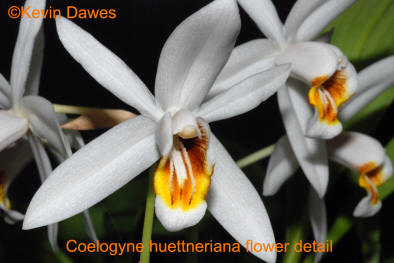Coelogyne huettneriana is often confused with Coelogyne flaccida but is easily distinguished by the greater amount of colouring over the lip and a lot of colour on the ends of the keels near the lip. Additionally, the 4 to 8 scented flowers per inflorescence have nothing like the beautiful cascading beauty of Coelogyne flaccida. As can be seen from the images above, the flowers are a long way from being described as pendulous. Coel huettneriana doesn't produce as many flowers and doesn't have the flower variations of Coel flaccida. I find it flowers much later than Coel flaccida (more like very late Spring to early Summer.
The flowers have a neat, clean-cut, attractive appearance and make for a very collectible orchid but the extra colouring takes away a bit of the attractiveness of the flower - almost a case of 'less is better'! The Coelogyne flaccida page on this site has an image comparing the two flowers.
Cultivation Suggestions: Coelogyne huettneriana hails from lower levels in Burma and Thailand and consequently needs warmth, as well as high humidity and moisture all year round. It is easy to grow in a well drained mix and flowers fairly easily.
Negatives: It produces a lot of plant material in proportion to the amount of flower and the flowers are presented slightly under the leaves
Rating: ♦♦♦ The flowers are individually very attractive. The pure, glistening white contrasts and highlights the beautiful orange/yellow and almost brown markings. A good move would be to obtain Coelogyne flaccida and then if you have sufficient space, you might acquire this orchid.
Sometimes sold as: Coelogyne flaccida or Coelogyne lactea.
Varieties: None known
Hybrids:
For some unknown reason Coelogyne huettneriana has added a very desirable trait to its hybrid offspring that encourages long lasting flowers. All four of the hybrids below hold their flowers for three to four weeks. This is a good flowering time span in anybody's language and especially in the orchid world where two weeks is impressive with many. Of course, there are always exceptions such as Cymbidium orchids - many of which will last in flower for eight weeks and this is why they are so popular in the commercial cut flower markets.
1. Coelogyne Kirribilli James - using Coelogyne speciosa as the pod parent ( Kevin Dawes 2015).
2. Coelogyne Kirribilli Gillian - using Coelogyne mooreana 'Brockhurst' as the pod parent ( Kevin Dawes 2015.
3. Coelogyne Kirribilli Phoebe - using Coelogyne chloroptera as the pod parent ( Kevin Dawes 2015).
4. Coelogyne Kirribilli Susan Dixon (Kevin Dawes 2018) - using Coelogyne flaccida as the pollen parent.
| < Coel fragrans | Coel lawrenceana > |
